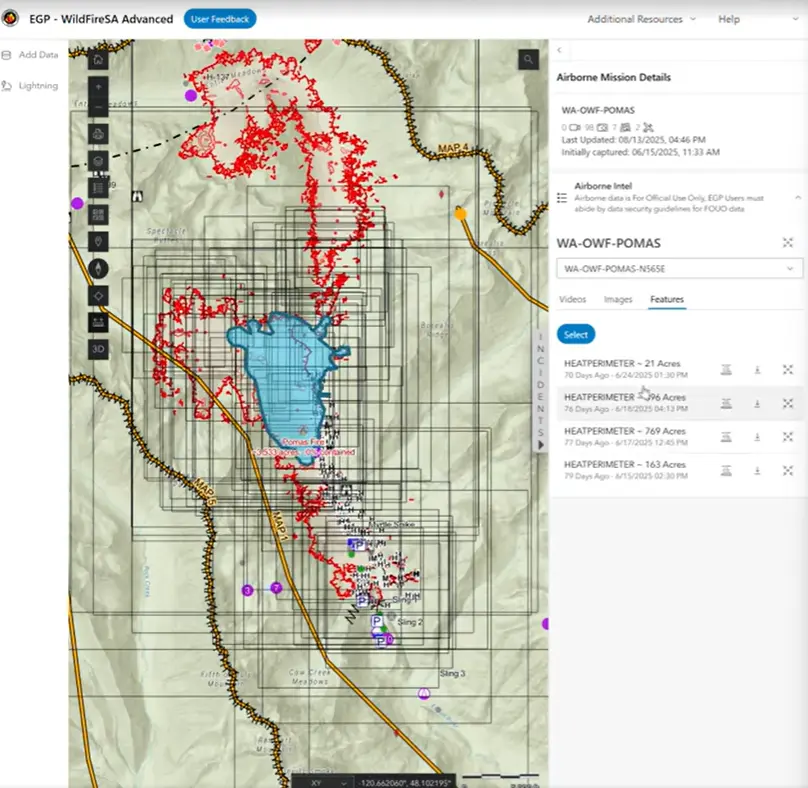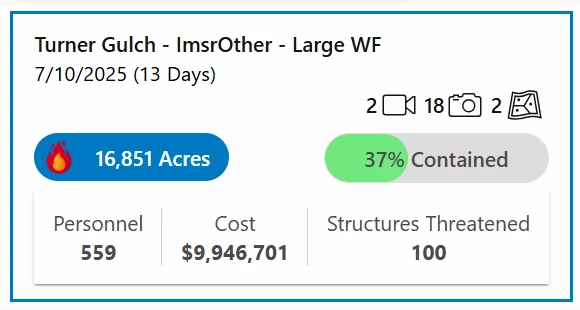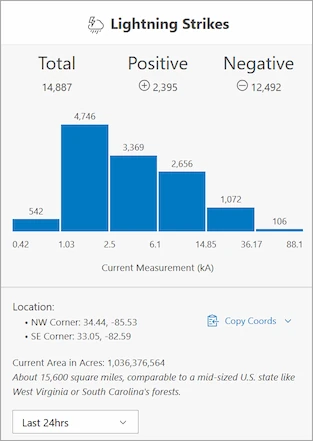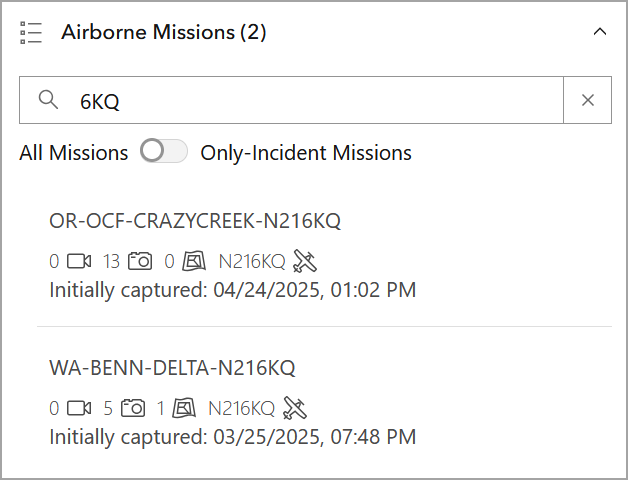WildFireSA Release Notes
This next-generation application is packed with enhanced tools for wildfire situational awareness and response, and introduces new features designed to improve user experience and access to real-time data.
- WildFireSA – https://egp.wildfire.gov/maps – EGP WildFireSA is the publicly available version streamlined for the not logged in, at-a-glance, quick view.
- 🔥WildFireSA Advanced – https://egp.wildfire.gov/sa – EGP WildFireSA Advanced is designed for the longer session to understand initial attack emerging details, overall region metrics, and provide the broader common operating picture with near-real-time data.
🔥= Features in WildFireSA Advanced Only
Version 2.1.1– December 10, 2025
Feature Updates
Service Fixes
- ShortHaul Service fields updated to support improved pop-up
- Minor changes to RADR Heat Detection Last 14 Days View service to improve synchronization and access
Additional Services added to the EGP Data Service Catalog Hub (available via “Add Data” in WildlandFireSA Advanced)
- Access (Trails, Roads, Networks)
- Values At Risk
- Fuels & Treatments
Bug Fixes
Application Fixes
- Added additional filters to the Airborne Mission Filters based on user request
- Security fixes
- Mobile Stability Fixes
- Additional Minor UI changes to Airborne, Add Data, Incident Filters, and Mobile
- Minor Cartography fixes in WildlandFireSA Advanced
- FireGuard Overview symbology slightly reduced
- FireGuard Polygon transparency reduced
- Reduced zoom visibility range of NWS Fire Weather Zone Forecasts to improve pop-up clutter
Coming Soon
- New basemaps Dark Mode & FAA Aeronautical Charts
- Add NOAA HMS Heat Detections Service
- Add IAA Fire Detections Service
- Improved Active Incidents Service (Jan/Feb 2026) to improve synchronization between IRWIN, WFIGS, SIT-209
- Lightning Download Additional Formats
- Additional Lightning Filters
- Adding NOAA 21 VIIRS data to Heat Detections Service
- Updated Heat Detection Service in both WildlandFireSA web maps to improve upon accuracy, initial noise reduction and algorithm improvements
Version 2.1.0 – November 14, 2025
Feature Updates
Updated WildFireSA User Interface and Mobile Support
- New Industry standard best practices
- Phone, Tablet, and Web support
- Dark or Light Mode
- Bookmarking remembers which panels you left off at
- 50% faster performance tested on 5G through basic broadband
- Public version loads in 8 to 15 seconds
- Logged-In version in 12 to 25 seconds
- Coordinated updated FAMAuth changes
- Improved Pop-up handling and larger pop-up window option
Improved UI based on user feedback Functions/Panels - now moved to left in web
- Briefing Metrics & Incidents
- Split into Active incidents into 2nd panel
- Improved GACC filter
- Active Incidents
- Improved incident filters
- Added mouse over to see point on map before flying to incident
- Added Dispatch Center and Discovery Data to top
- Improved UI on displaying attributes
- Lightning
- Added quick turn visualization on/off at top
- Added quick link to print GeoPDF
- Faster performance lightning visualization
- Download Data
- ATU download added this summer moved to panel on left
- Add Data
- Improved filter
- Checks for AGOL Item cartography and name
- Airborne
- Made Aircraft tail # secondary to improve searching
- Only 1st 20 image bounding boxes
- Improved UI on interaction with videos and imagery
- Save Map (recently released)
- now supports up to 5 presets to turn on/off layers, add layers, re-order, and change opacity (remove layers is in upcoming releases)
- Mobile
- Fully supported in tablet and phone and portrait and landscape mode
- Layers supported in drawer at bottom
- Pop-ups moved to drawer at bottom
- All Function panels supported by swiping up
Services and Catalog Updates
- Web Map updates
- Performance initial load improvement to basemap. The map delays are now the basemap tiles, not the fire map or layers
- NIFS Additional Event Points not commonly used moved to default off
- NIFS Perimeters not commonly by GISS used removed
- New NIROPS and Mission Request service in catalog and WildFireSA Advanced Map
- Added to EGP WildFireSA Data Service Hub/Catalog
- National Monthly Significant Fire Potential
- National 7-Day Significant Fire Potential
- IAA Requests (Mission, NIROPS)
- NIFS Incident Repair Status Service
- BLM National Repeaters
Bug Fixes
- See UI updates
Coming Soon
- Improved Base Map Tile performance handling
- Additional Minor UI changes to Airborne, Add Data, Incident Filters
- Map Presets – Remove layers
- Updated Heat Detection Layers
- Updated Sage Grouse Habitat
- New Features Queued:
- Query Layer Features
- Resource Tracking Widget
- FireGuard quick lookup
- Additional Lightning download formats
- Additional Lightning filters
- Integrate AFF Flight Tracking
Version 2.0.11 - October 21st, 2025
Feature Updates
- Legacy EGP decommissioned September 30th 2025.
- 🔥Save Personal Map Configuration – users can now save one map with the current map state. This includes the following elements:
- Active Layers
- Added Layers from Data Catalog
- Layer Order
- Layer Opacity
- Basemap
- Zoom Level
- Map extent
- 🔥Webmap size reduced by 20% to speed up initial load time
Bug Fixes
-
Lightning Layer and Strike Counter Restored and transitioned to new data provider (Vaisala)
-
ATU layer “volume” field now populated with correct values
Coming Soon
-
Remove Layer functionality within the Save Personal Map Configuration and new User Interface
-
New WildFireSA User Interface coming: Mobile Friendly, more responsive, improved navigation for Airborne, Add Data, Lightning, and Map interactions
Version 2.0.9 - September 17th, 2025
Feature Updates
- Added Wildland Fire History Current Decade from NIFC WFIGS now also back in WildFireSA Public with improved cartography.
- Over 40 Weather services added this Summer 2025 in the EGP Data Services Hub - https://egp-nifc.hub.arcgis.com/ alongside over 150 total curated services. Visit the site and search or explore the "Data Categories" such as weather. These additional weather services are all available in the WildFireSA and curated from NIFC, NWS, NowCoast, AirNow, and other NOAA Programs.
- 🔥 New RADR Service 14 day service perimeter heat detection service is now available under Satellite Heat Detections - The RADR-Fire system continuously acquires satellite imagery of active wildfires as it becomes available and maps fire boundaries using advanced analytics. Map classes include heat perimeter (burned), intense heat, cloud, and no data regions.
- 🔥The Additional Telemetry Unit (ATU) Drop Points for Rotary and Fixed Wing service has been updated to simplify visualization and support ATU feature download
🔥Airborne Missions
- The IAA Airborne Mission Visualization service has been updated to support use and download in Field Maps as well. Click on any video, imagery bounding box, or feature, and you can download in the various formats direct to your phone.
Bug Fixes
- ATU Feature service now displays accurate data and is updated every 1 hour.
Coming Soon
-
WildFireSA Mobile and 'multi-modal' support is coming in October 2025. The current WildFireSA was initially setup to transfer over features and parity from legacy. Now, an updated lightweight, modern User Interface (UI) design is being launched. All the same features in WildFireSA will be supported with an improved UI in web, tablet, and phone support. This also includes other requested minor improvements such as handling improved varied screen resolutions, improved pop-up options, and various improvements to all the 'widgets' and 'panels' in the current WildFireSA for an improved user experience. Your feedback has been invaluable to this major update.
-
🔥 WildFireSA Advanced “Save a map configuration” - The largest feature requested from legacy and WildFireSA is a Save Map Configuration. This efficiency will allow you to save the zoom, latitude/longitude, application state, layers changes (on/off, added services, group changes, etc.). This is currently in testing and will allow you to save one map configuration with your EGP account. After release, future considerations for more options will be considered if feedback demands such.
-
🔥 Lightning - The lightning service will be transitioned to a new data provider in October/November 2025. This will include a cartographic update which combines user feedback on the various visualization inputs. Along with this, improvements to the Lightning download will include improved integration with visualization, a very fast visualization experience, and additional requested download formats.
-
🔥 IAA Airborne improvements - To support sharing video and imagery in the field where network is available, a temporary QR Code share capability is coming. With the new Field Maps (and any WildFireSA app access via web, mobile, or phone), when you click on the map and pull up a video, imagery bounding box or other IAA feature, the pop-up window will include a scannable, time-limited temporary QR Code, which an approved NWCG position team member can scan and download to their device.
-
🔥 WildFireSA Advanced additional features: Import KML, more download/export options, n-going service curation and cartographic improvements based on your feedback, UI/feature improvements driven by feedback prioritization, Automated Flight Following (AFF) integration
Version 2.0.8 - September 3rd, 2025
Feature Updates
- A latitude and longitude indicator bar was added to the bottom of the map that will change to indicate your current lat/long as you navigate the map
🔥Airborne Missions
Bug Fixes
-
When you click a mission in the mission accordion, you get routed to the mission details page, not the incident details page with associated airborne data.
-
Polygon highlighting feature corrected and features will now be highlighted on the map when and Airborne Missions on list are hovered over.

Version 2.0.7 - August 20th, 2025
Feature Updates
- WildFireSA Cutover - Completed successful cutover to the new WildFireSA application. The legacy version of the application will remain accessible until September 2025.
URL Redirects
-
Legacy URLs are now automatically redirected to the current WildFireSA URL.
-
Incorrect URLs will route to an error page which will allow a user to select the SA application they wish to access.
🔥Airborne Missions
-
Mission filters now remain in place after refresh.
-
Missions list now shows most recently updated data first.
-
Airborne Mission cards now display the last modified date.
Version 2.0.6 - August 5th, 2025
Feature Updates
-
An announcement banner has been added to alert users of any important outages or updates
-
Map data now refreshes every hour, shows only the past 14 days, and automatically reflects detected changes
🔥Airborne Missions
-
Users may now download multiple data items at a time by selecting the Select All box before selecting the download icon
-
Enhanced Airborne Feature heat perimeter details
Version 2.0.5 - July 23rd, 2025
Feature Updates
🔥Airborne Missions
-
More than one mission per incident is now visible in the Airborne Missions section and in Active Incidents within Airborne Intel
-
The Airborne Missions section will now automatically refresh every 5 minutes
-
Images, Videos, and Features are now sorted by time
-
Added a mission card to individual incidents, showing the number of Images, Videos, and/or Features available for the incident

Bug Fixes
-
🔥Fixed shared pin redirect issue after FamAuth login. User will be redirected back to original shared pin URL after FamAuth login prompt rather than the default homepage.
-
Fixed a default date issue that was causing incorrect dates for some incidents. Incidents with no available date information will now appear without a date rather than showing a default/incorrect date
Version 2.0.4 - July 9th, 2025
Feature Updates
- An action bar has been added to improve U.I. for left side widgets
- Map loading feature added
Bug Fixes
- Bug fix for map zoom
- Minor U.I. updates
Version 2.0.3 - June 25, 2025
Feature Updates
🔥Airborne Intel
- Hovering over a feature KML from the Airborne Intel list will now highlight that feature on the map.
- The view image button has been removed. To view an image, simply select the image name from the Airborne Intel list.
- Images visible on the map are now greyed out on the Airborne Intel list.
- A star is now displayed beside the actively previewed image.
Bug Fixes
- The Airborne Missions and Lightning Strikes features will now only appear in WildFireSA Advanced.
- Various U.I. improvements.
Version 2.0.1 and 2.0.2 - June 06, 2025
Feature Updates
🔥Lightning Strikes
The Lightning Strikes feature let's you view and export strike counts. You can access the feature through the Lightning Strikes button in the upper right of the menu bar.

🔥Airborne Missions
The Airborne Missions section has been added to the Incidents panel. The Airborne Missions section let's you search for missions as well as filter only incident missions.

Active Incidents: Incident Details
- Added accordions to the incident details.
- Added a checkbox to remove “No Value” entries.
Legend
- Added accordion to the map Legend.
U.I. enhancements
- Increased the width of the Layers menu for improved usability. -Updated the default basemap’s thumbnail to closer align with the map’s appearance.
- 🔥Minor Cartographic Symbol and Pop-up improvements to Aviation Services, DART Symbology by Apparatus Type, and FireGuard.
Bug Fixes
- Fixed an issue with swapping between 2D to 3D URLs.
- Fixed a scaling issue with overlapping U.I. on laptops.
- Fixed an issue with active incidents filters being hidden.
- 🔥Fixed an issue with the EGP Catalog filter tag scrolling.
Version 2.0.0 - Beta Release - May 1, 2025
Feature Updates
-
Incident Detail & Briefing Metrics Integration – Integrated Briefing Metrics & Incident Panel (right panel) to bring together the previous separate briefing concept into a single view. National and GACC Metrics updated every 5 minutes are added to the top of the right panel. Additionally, Search, Filter, List and see Incident Details in the Incident Panel. For a selected incident, there is now a One click “share” a direct link of the incident, lat/long, zoom, GACC, and even if in 2D or 3D mode. 🔥In WildFireSA Advanced, additional incident details are included on incident resources, operational notes, and ICS conditions detail
-
🔥Airborne Data available by Incident – In the same panel, for a selected incident, Airborne Intel is now grouped with active incidents for better organization and accessibility. Users can now directly see if an incident has airborne data within the incident card in the incident panel. (to see all missions in 1 list coming next sprint)
-
New UI changed to Grouped Layers and Add Data Experience – Common layers are now grouped for ease of use. A new “Add Data” interface (left panel) allows for quick adds of the EGP Curated data catalog, unique URLS, files or from other AGOL accounts can be easily added or removed (Save Session coming soon next).
-
Updated EGP Data Catalog – The WildFireSA Advanced “Add Data” widget is driven by the new EGP Data Hub Catalog. Linked from the portal, and requires a NIFC AGOL account to access, the EGP Curated data catalog of well over 100+ items includes improved metadata common with well-managed AGOL items.
-
Updated GIS Tool widgets included – New “black” tool buttons offer Simplified basic grouped layers with advanced “add Data” widget, dynamically updated legend, 3D mobile-friendly widget to replace legacy Fire Globe 3D application, an alpha Print widget, standard Measure tools, and a capability to drop and share Pins
-
Cartographically Designed Map Experience – To support the best view for Situational Awareness, stay informed, respond effectively to changing conditions, the modernized designed a new web map and grouped layers approach with 100s of feedback across over 60 web features services from dozens of wildland fire stakeholders (GISS, SITL, SIngle Resources, Dispatchers, more). This includes updates to symbology, labels, time refresh, grouping, transparency, pop-ups, and zoom levels ensure that users have the most accurate and easily interpretable data. Zoom changes the visible features to relevant data to provide that quick SA.
-
🔥WildFireSA Advanced Web Map brings Near Real-Time into Focus – This web map goes further to emphasize initial attack, emerging incidents, or when fires go on a run. The overall context is centered on near real-time data such as DART Resource Tracking, NIFS Operational Features, FireGuard Heat Detection, IAA Aircraft Intel, Weather Station Red Flag indicators and Active Incidents with rich pop-up content.
-
Web Maps are hosted and directly available via NIFC AGOL – All EGP Web Maps are now hosted on NIFC AGOL (access via Apps or directly with a NIFC AGOL account). The changes also allow for consuming a light WildFireSA WebMap version in Field Maps (Training to come).
-
User Feedback Form link – As this exciting update is rolled out, feedback from the fire user community is valuable to guide change and enhancement prioritization in data, features, and design (UI and Cartographic). The help page includes a feedback form to assist EGP with guidance on fine-tuning the features to best meet your needs.
Mid-May Release
Fixes and Enhancements coming – Overall 30 items for UI fixes are queued from feedback testing for UI improvements and minor fixes for:
- UI improvements Layer List, Briefing Metrics Display, and Incident Search Filtering
- Performance and Display limitations to the print tool and 3D Layers.
- 🔥Add Data panel add/remove fixes
- 🔥New AI Heat Detection service integration with PNNL RADR
- 🔥Airborne Intel Product features beta testing U.I. improvements
- New EGP FLIGHT application
Key Highlights in the Near-Term Backlog over the Spring/Summer 2025
An additional 100 improvements and updated prioritized features have been captured in a roadmap with feedback from stakeholders and coming during this period. Highlights:
- Further Data Catalog and WildFireSA Service Rationalization
- WildFireSA Mobile-Friendly improvements
- EGP and NIFC Camera Viewshed Coverage improvements
- Training on use of WildFireSA Web Maps in Field Maps and on the EGP Data Catalog
- Updated Resource Tracking Dashboard and Dynamic Metrics
- 🔥Personal View Save (Add/Remove Layers, GACC Region, re-open session)
- 🔥Automated Flight Following integration
- 🔥NIFC AGOL Login integration
- 🔥Further Airborne request IAA/NIROPS integration
- 🔥Improved Export Incident-centric Views.
- 🔥Airborne Missions without Incident View
- 🔥Lightning Explorer Tools Widget # Markdown syntax guide

